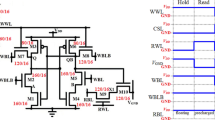Abstract
Multi-port SRAMs are often implemented using static random access memory (SRAM) due to its fast operation and the ability to support multiple read and write operations simultaneously, thus increasing data throughput in embedded systems and meeting the expected demands of parallel or pipelined microprocessors. With the continuous scaling of transistor feature size, designing low power robust memories and investigating their failure characteristics become critical. In this paper, we study the defects occurring in the multi-port SRAM cells. The memory is modeled at the transistor level and analyzed for electrical defects by applying a set of test patterns. Not only have existing models been taken into account in our simulation but also a new fault model, namely, simultaneous deceptive destructive read fault for the multi-port memory is introduced. In addition, we extend our study to the defect tolerant design of memories by proposing a differential current-mode sense amplifier for 3-port SRAM based register file. We examine the fault models of resistive defects within the SRAM cell and its failure boundary. A read disturb fault for multi-port memories is tested on the faulty cell by simultaneous read operations with different numbers of ports. Experimental results show that the proposed current-mode sensing scheme has improvements for memory fault-tolerance of resistive defects at 4.6× for dual-port read and 5.8× for 3-port read compared to voltage-mode sensing with 0.18 μm manufacturing process technology.
















Similar content being viewed by others
References
Adams RD (1996) Extensions of static random access memories, fault modeling and examination of patterns for fault detection. Masters Thesis, Dartmouth College
Al-Ars Z, van de Goor AJ (2001) Static and dynamic behavior of memory cell array opens and shorts in embedded DRAMs. In: Proceedings of Design, Automation and Test in Europe, Munich, 13–16 March 2001, pp 496–503
Baker K, Gronthoud G, Lousberg M, Schanstra I, Hawkins C (1999) Defect-based delay testing of resistive vias-contacts a critical evaluation. In: Proceedings of International Test Conference. IEEE, Piscataway, pp 467–476
Chandrakasan A, Bowhill WJ, Fox F (2000) Design of high-performance microprocessor circuits. IEEE, Piscataway
Cypress Semiconductor (2007) Understanding specialty memories: dual-port RAM. Technical article. http://www.cypress.com/
Dilillo L, Girard P, Pravossoudovitch S, Virazel A, Borri S, Bastian Hage-Hassan M (2004) Resistive-open defects in embedded-SRAM core cells: analysis and march test solution. Test Symposium, Asian. IEEE, Piscataway, pp 266–271
Dilillo L, Girard P, Pravossoudovitch S, Virazel A, Borri S, Hage-Hassan M (2004) Dynamic read destructive fault in embedded-SRAMs: Analysis and march test solutions. Proceedings of the IEEE European Test Symposium. IEEE, Piscataway, pp 140–145
Dilillo L, Girard P, Pravossoudovitch S, Virazel A (2005) Resistive-open defect injection in SRAM core-cell: analysis and comparison between 0.13 μm and 90 nm technologies. Proceedings of Design Automation Conference. IEEE, Piscataway, pp 857–862
Dilillo L, Girard P, Pravossoudovitch S, Virazel A, Bastian Hage-Hassan M (2005) Resistive-open defect influence in SRAM pre-charge circuits: analysis and characterization. European Test Symposium. IEEE, Piscataway, pp 116–121
Gieseke B et al (1997) A 600 MHz superscalar RISC microprocessor with out-of-order execution. Paper 10.7 ISSCC Digest of Technical Papers, pp 176–177
Hamdioui, S, van de Goor AJ (1998) Fault models and tests for two-port memories. Proceedings of IEEE VLSI Test Symposium. IEEE, Piscataway, pp 401–410
Hamdioui, S, van de Goor AJ (1998) Consequences of port restrictions on testing two-port memories. Proceedings of International Test Conference. IEEE, Piscataway, pp 63–72
Hamdioui S, van de Goor AJ (1999) Port interference faults in two-port memories. Proceedings of IEEE International Test Conference. IEEE, Piscataway, pp 1001–1010
Hamdioui S, van de Goor AJ, Eastwick D, Rodgers M (2001) Realistic fault models and test procedure for multi-port SRAMs. IEEE International Workshop on Memory Technology, Design and Testing. IEEE, Piscataway, pp 65–72
Nagaraj P, Upadhyaya S, Zarrineh K, Adams D (2001) Defect analysis and a new fault model for multi-port SRAMs. IEEE International Symposium on Defect and Fault Tolerance in VLSI Systems. IEEE, Piscataway, pp 366–374
Needham W et al (1998) High volume microprocessor test escapes—an analysis of defects our tests are missing. Proceedings of the International Test Conference. IEEE, Piscataway, pp 25–34
Park I, Powell M, Vijaykumar T (2002) Reducing register ports for higher speed and lower energy. Proceedings of 35th Annual IEEE/ACM International Symposium on Microarchitecture, 2002 (MICRO-35), Istanbul, 18–22 November 2002
Powell TJ, Cheng W-T, Rayhawk J, Samman O, Policke P, Lai S (2003) BIST for deep submicron asic memories with high performance application. Proceedings of IEEE ITC, International Test Conference. IEEE, Piscataway, pp 386–392
Rabaey J, Chandrakasan A, Nikolic B (2003) Digital integrated circuits: a design perspective, 2nd edn. Prentice-Hall, Englewood Cliffs
Tseng K, Asanovic JH (2006) A speculative control scheme for an energy-efficient banked register file. IEEE Trans Comput 54:741–751
van de Goor AJ (1998) Testing semiconductors memories, theory and practice. ComTex, Gouda
Author information
Authors and Affiliations
Corresponding author
Additional information
Responsible Editor: N. A. Touba
Rights and permissions
About this article
Cite this article
Liu, L., Nagaraj, P., Upadhyaya, S. et al. Defect Analysis and Defect Tolerant Design of Multi-port SRAMs. J Electron Test 24, 165–179 (2008). https://doi.org/10.1007/s10836-007-5023-5
Received:
Accepted:
Published:
Issue Date:
DOI: https://doi.org/10.1007/s10836-007-5023-5




